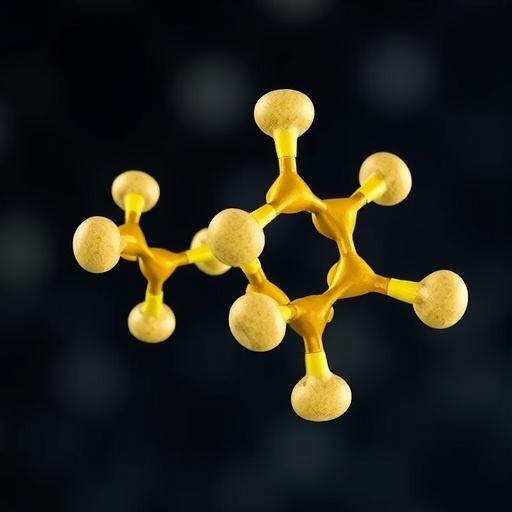A groundbreaking study has emerged in the field of organic chemistry, showcasing a novel approach to synthesizing compounds that could redefine our understanding of antimicrobial agents. The research, conducted by a team of skilled scientists including Al-Saleem, Al-Humaidi, and Elhenawy, has utilized choline hydroxide as a catalyst in what is termed an eco-friendly synthesis process. This innovative method leads to the creation of 5-arylidene thiazol-4(5H)-one, a compound that has not only piqued interest for its structural attributes but also for its potential therapeutic applications.
The significance of this research cannot be overstated, as the antimicrobial resistance crisis looms larger in the medical community. Antibiotic-resistant strains of bacteria have cultivated a pressing need for researchers to identify and develop new classes of antimicrobial agents. By exploring alternative methods of synthesis, this research paves the way for environmentally sustainable practices that also deliver potent biological activity.
Choline hydroxide, the key component in their synthesis, is a quaternary ammonium compound known for its excellent solubility and low toxicity. Its application in organic synthesis is relatively novel, setting this research apart from traditional methods that often rely on hazardous reagents or solvents. This environmentally friendly approach aligns well with the current scientific ethos that promotes sustainability and green chemistry, helping to diminish the ecological footprint of chemical manufacturing.
Upon employing choline hydroxide in their synthesis process, the researchers succeeded in producing the target compound with remarkable efficiency. The structural characterization and the purity of the synthesized 5-arylidene thiazol-4(5H)-one were rigorously validated through various spectroscopic techniques. Techniques such as Nuclear Magnetic Resonance (NMR) and Infrared (IR) spectroscopy were utilized to confirm the molecular structure, providing a robust framework that supports the reliability of their findings.
Further expanding the impact of their successful synthesis, the research team conducted a thorough antimicrobial evaluation of the newly synthesized compound. In vitro tests were performed against a wide spectrum of microbial strains, including both Gram-positive and Gram-negative bacteria. The results were promising, revealing significant antimicrobial activity that opens avenues for the development of new therapeutic agents. This aspect of the research highlights the urgency and relevance of discovering alternatives to existing antibiotics amid growing resistance.
Additionally, the research incorporated in silico studies to elucidate the potential mechanisms of action of the synthesized compound. Molecular docking simulations were employed to predict how the compound interacts with specific bacterial enzymes and receptors. These computational methods provided deeper insights into its bioactivity, thus fortifying the experimental findings with theoretical validation. The synergy of experimental and computational approaches enhances the overall credibility of the claims made in the study.
What is particularly fascinating about this research is its dual focus on both sustainability and efficacy. By choosing choline hydroxide—an eco-friendly reagent—the researchers have set a precedent for others in the pharmaceutical field to follow. In an era where environmental concerns are increasingly taking center stage in scientific discourse, such innovative approaches not only to synthesize but also to evaluate new antimicrobial agents are crucial.
The collaborative nature of this research is also worthy of note, as it brings together experts from diverse fields, allowing for a comprehensive exploration of the compound’s properties and potential applications. This interdisciplinary approach is essential when tackling complex issues such as antimicrobial resistance, making it a model for future studies aiming to bridge multiple areas of expertise.
In conclusion, the study’s findings mark a significant advancement in the ongoing effort to develop new antimicrobial compounds through eco-friendly methods. By harnessing the properties of choline hydroxide in the synthesis of 5-arylidene thiazol-4(5H)-one, the researchers have not only created a promising candidate for future medications but also demonstrated the larger potential for green chemistry in drug discovery. As the scientific community continues to respond to the challenges posed by resistant bacteria, such innovative research will undoubtedly play a pivotal role in shaping the future of antimicrobial therapy.
The implications of this study extend far beyond its immediate findings. It acts as a clarion call for researchers to pursue sustainable practices while maintaining scientific rigor. The path that Al-Saleem and co-researchers have embarked upon is one that encourages the exploration of not just what can be synthesized, but how it can be done responsibly. Thus, the ripple effects of this research will likely inspire a new wave of methodologies in organic synthesis that prioritize both efficiency and environmental stewardship.
As these developments unfold, it will be essential for stakeholders in the pharmaceutical and environmental sectors to examine and support such research initiatives. By investing in sustainable approaches, we can ensure a healthier future not only for our societies but also for the planet we inhabit.
As we look forward to further advancements stemming from this study, one can only hope that the antimicrobial landscape will soon be populated by new, effective agents, heralding a new chapter in the fight against infectious diseases.
Subject of Research: Eco-friendly synthesis of antimicrobial agents
Article Title: Choline hydroxide mediated eco-friendly synthesis of 5-arylidene thiazol-4(5H)-one clubbed coumarin: antimicrobial evaluation and in silico studies.
Article References:
Al-Saleem, M.S.M., Al-Humaidi, J.Y., Elhenawy, A.A. et al. Choline hydroxide mediated eco-friendly synthesis of 5-arylidene thiazol-4(5H)-one clubbed coumarin: antimicrobial evaluation and in silico studies.
Sci Nat 112, 74 (2025). https://doi.org/10.1007/s00114-025-02026-7
Image Credits: AI Generated
DOI: https://doi.org/10.1007/s00114-025-02026-7
Keywords: antimicrobial synthesis, eco-friendly chemistry, choline hydroxide, thiazole derivatives, green chemistry, drug discovery.




